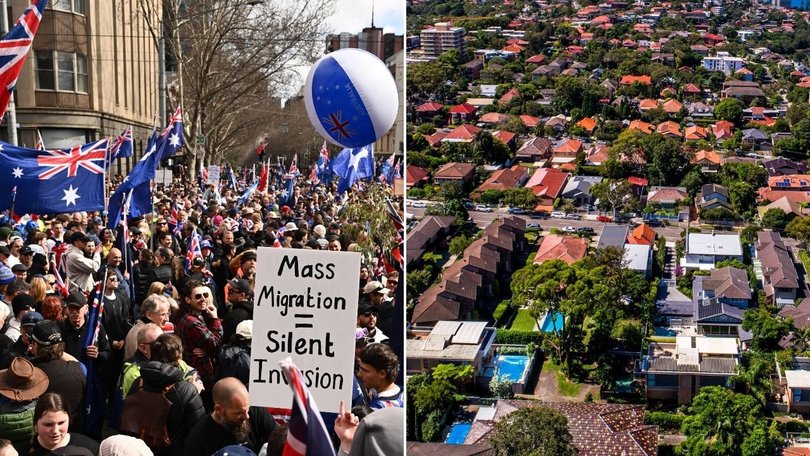Immigration ‘scapegoated’ for Australia’s housing crisis say experts

Recent nationwide rallies against mass-immigration were widely condemned after they were joined by violent neo-Nazis.
White supremacists aside, the protests were full of everyday Australians who say soaring house prices and overstretched public services motivated their marching.
One Queensland man who attended a March For Australia rally, 62-year-old Chris Fisher, said he came from a migrant family himself, and told 7NEWS.com.au the demonstration against mass immigration was the first protest he has ever marched in.
Sign up to The Nightly's newsletters.
Get the first look at the digital newspaper, curated daily stories and breaking headlines delivered to your inbox.
By continuing you agree to our Terms and Privacy Policy.He showed up in support of a healthcare system he said “has great difficulty keeping up with the demands placed on it”, and to push for vulnerable Australians to be able to access housing amid a “dramatic increase in house prices”.
“I know I am not alone in my views and concerns,” he said.
“I would gladly welcome 500,000 immigrants a year if the conditions were right in this country. By this I mean adequate housing and a social infrastructure to support this.”
But experts on the economy and human rights say the concerns of such activists are “misdirected”.
Australia Institute economist Matt Grudnoff told 7NEWS.com.au that an equation which suggests immigration is the cause for these concerns oversimplifies the issues at hand, and leaves out several key factors.
He explained what would happen if skilled workers — who make up 71 per cent of Australia’s annual migrant intake — stopped being a part of our economy.
“If that did happen, we wouldn’t be able to produce the goods and services we want, or more accurately, firms that were able to produce those goods would put up their prices,” Grudnoff said.
“It would cause inflation, which would push the Reserve Bank to increase interest rates.”
If just 25,000 skilled visas were cut from the annual migration intake of 185,000 — as former Opposition Leader Peter Dutton suggested as a solution to the housing crisis last year — it could cost the budget more than $10 billion annually by the late 2040s, according to public policy advisory organisation the Grattan Institute.
That annual figure equates to just under a third of the entire $33.9 billion in government funding committed to the nation’s state‑run public hospitals and health services in the 2025–26 Budget.
This same principle of demand can be applied to concerns of immigration negatively impacting job availabilities and wages.
“On average, a region with a 10 per cent larger migrant share reports wages 1.3 per cent higher,” says the Grattan Institute.
‘Absolutely misdirected’
Given the cost-of-living crisis, Grudnoff said “it’s not surprising that people are feeling the financial pain”.
But he said the concerns of protestors who believe this pain is caused by migration are “absolutely misdirected”.
“There are problems with our economic system and our social system that do need fixing, but if you don’t tackle the right ones, then all you’re going to do is perpetuate the problems,” Grudnoff said.
Fisher said he is one of many people who have “worked bloody hard” in hopes of entering “into retirement financially secure ... with real value in their home. Many with a second investment property.”
It’s a dream that Australians have been encouraged to chase, in a country where pension payments pale against the cost of a comfortable retirement. It’s a dream he wants for future Australians.
But the catch-22 is that those cashing in on financial security in the form of housing investments might be the very ones stopping the next generation from accessing it.
What’s really to blame for the housing crisis?
The housing crisis has been mounting for the past 20 years, with prices beginning to soar not long after the capital gains tax discount came along in 1999, Grudnoff said.
“We’re building houses faster than the population is growing,” he said.
Between 2001 and 2021 there was a 39 per cent increase in dwellings in Australia, and a 34 per cent boost to the population, according to Australia Institute.
Grudnoff said the housing sector strain is more “about who is buying those houses”.
“It’s not a lack of supply so much as an increase in demand ... and what we’ve seen in particular is investor demand.
“Capital gains tax discount and negative gearing have combined to make investing in housing a very tax-effective way to make income, and lots of investors have rushed into the market, and they’re outbidding first-home buyers.
“We once saw housing as a safe and secure place to live, but that changed — we now see housing as an investment, a way to grow the nest egg, a way to secure your financial future. We’ve turned it into a financial asset.”
And, usually, financial assets going up is a good thing.
“I’m not against investment, I’m an economist,” Grudnoff said. “But you can invest in all sorts of things ... and if everyone got really excited and started investing in the stock market, then the price of shares would go up and they might be overvalued.
“But if (stocks were overvalued) no one would be in housing stress, because the stock market does not have that same spillover impact. We need to stop seeing housing as an investment good, and start seeing it as a safe and secure place for people to live.”
‘Scapegoated’ for a more complex problem
The March for Australia protests were marred by violence shortly after finishing, with neo-Nazis storming a sacred Indigenous camp in Melbourne and Palestinian brothers being attacked in Sydney.
Australian Human Rights Commissioner Giridharan Sivaraman told 7NEWS.com.au that he was also contacted by several community groups before and after the March For Australia rallies in August.
“All of whom expressed great distress, anxiety, and just a feeling of being unsafe,” he said.
“Some of them told me they didn’t want to leave their homes on Sunday,” Sivaraman said. “That’s the problem with a march like this, it makes people feel really unsafe.”
“Unfortunately migrants get scapegoated for much more complex problems.”
“It could be about tax policy, or the way the banks are acting, or overseas factors like tariffs that are impacting prices here. All of those issues are really complex and require complex solutions. It’s a lot easier to blame the brown person.”
He said that vulnerable people of various demographics are often targeting with these simple but false solutions, and oftentimes it happens on social media.
“White supremacists see migration as a threat, and so they will immediately attach themselves to any anti-immigration rhetoric or march, and infect it with the bile of their really violent racism,” Sivaraman said.
“They often use misinformation and disinformation to promote views that are completely false.
“They’ll promote false statistics, or create fear where there shouldn’t be any ... That’s a really common tactic.
“They also often operate in echo chambers, where the truth can’t easily enter.”
‘Politicians need to be really careful’
Sivaraman also noted that online commentary is often an amplification of political rhetoric, which is why he said “politicians need to be really careful about what they say”.
Foreign Minister Penny Wong previously spoke out about the March for Australia protests and the Coalition for weighing in, slamming the Opposition for “using migrants as a scapegoat for a housing crisis”.
Jacinta Nampijinpa Price was pushed out of the Liberal party last Wednesday over a sentiment she shares with Fisher on “the magnitude of migration”, expressed as a comment that her party was bringing in more Indian migrants to bolster its vote.
Wong spoke out again after this, emphasising that the views shared at the anti-immigration protests did not reflect the broader community.
“Those protests didn’t represent Australia. I don’t think Australian values are values of division,” she said.
— With AAP
Originally published on 7NEWS
